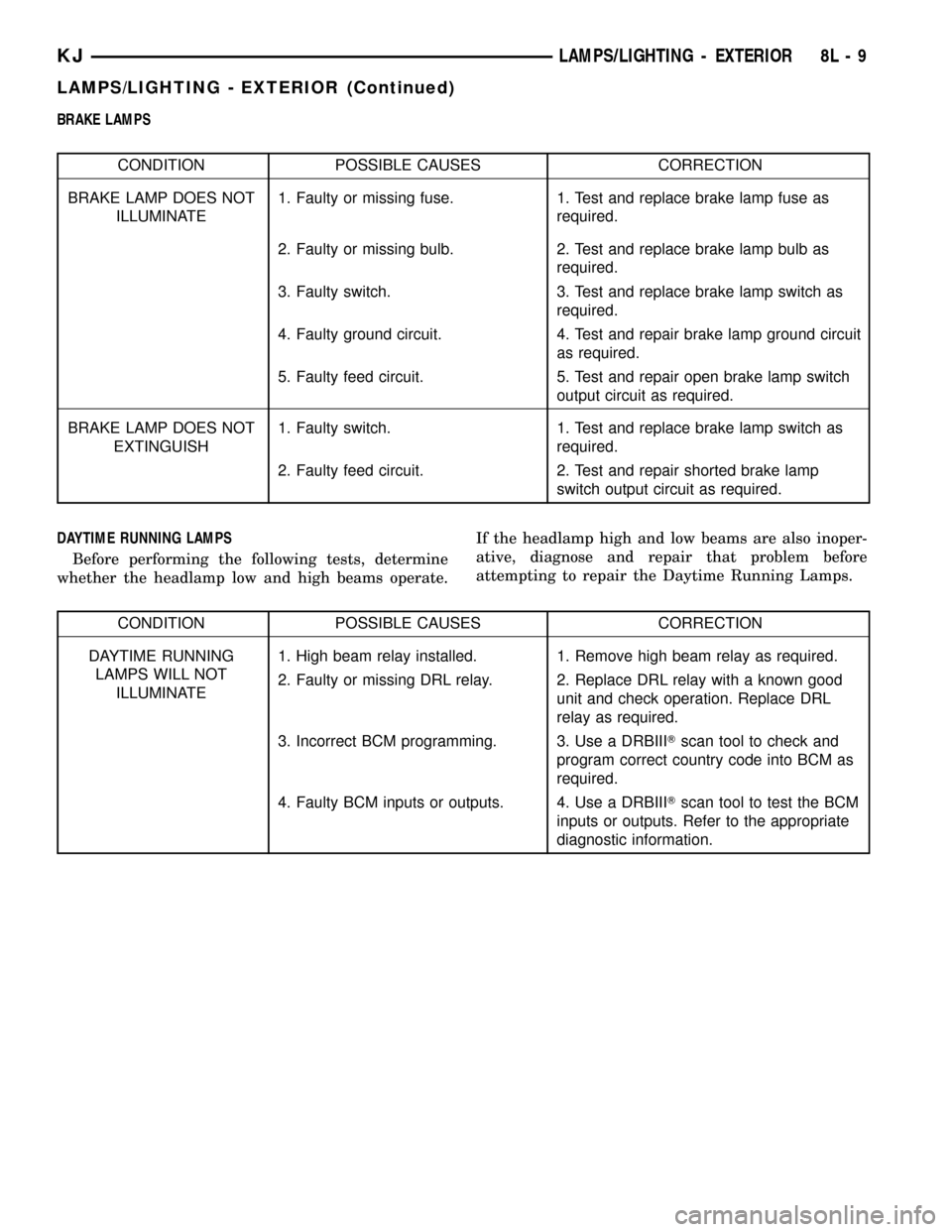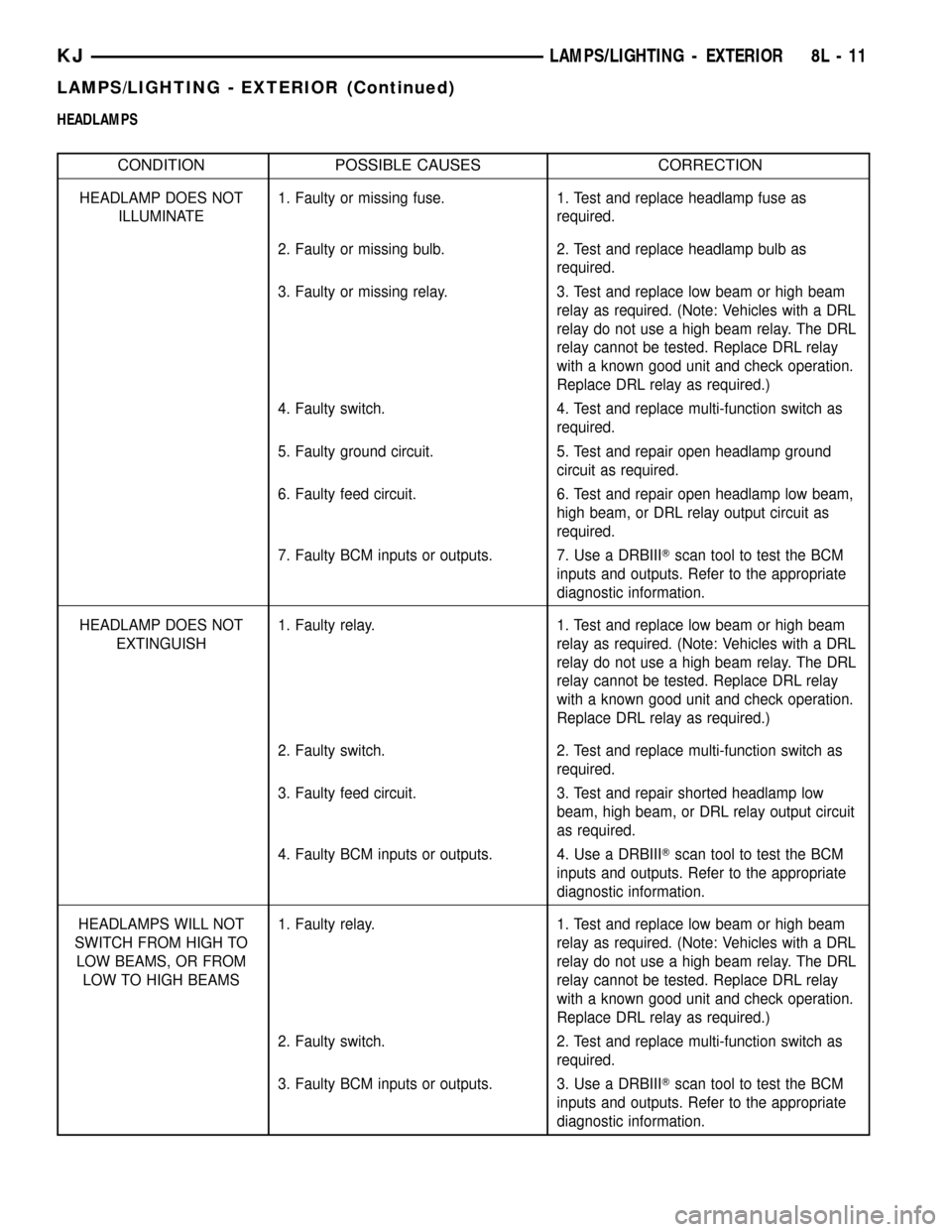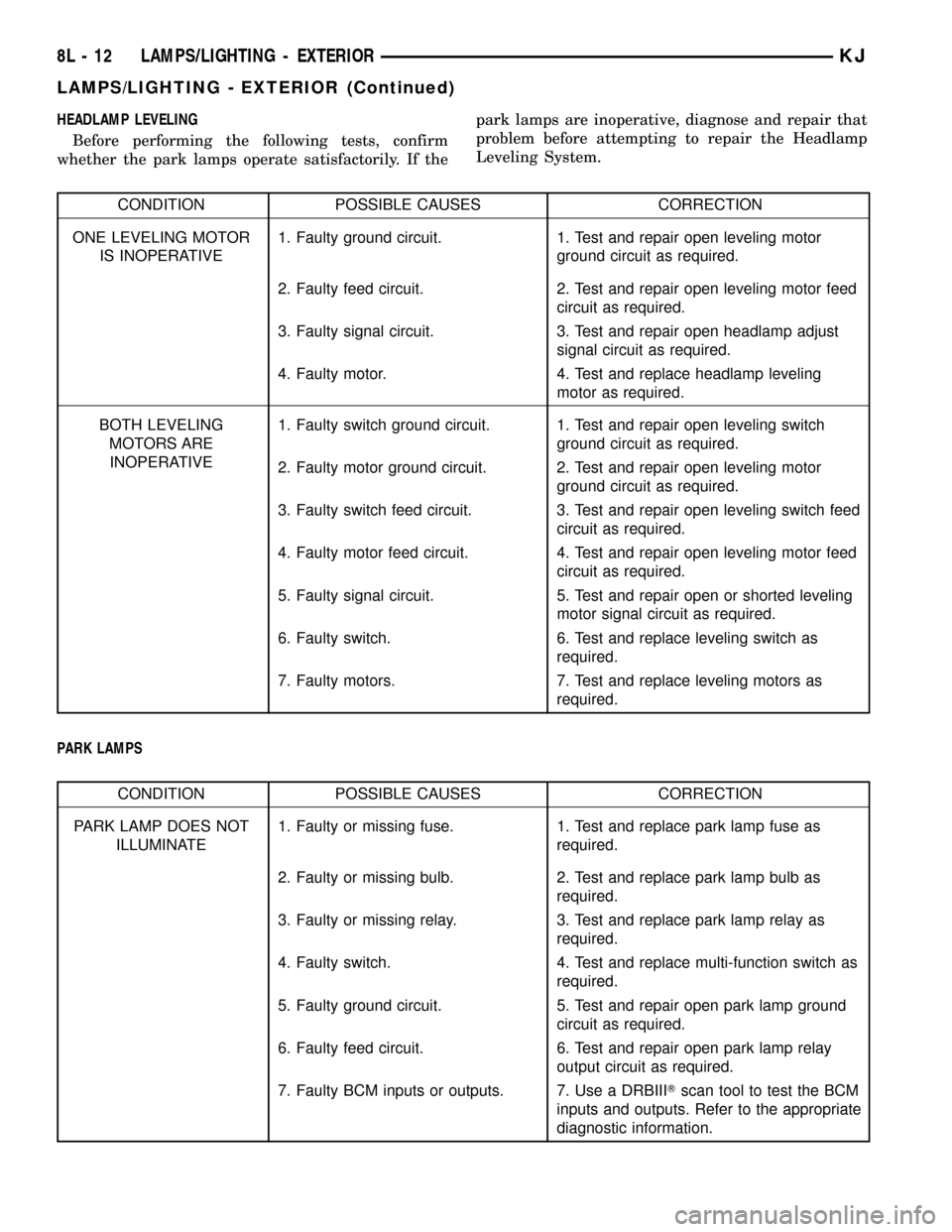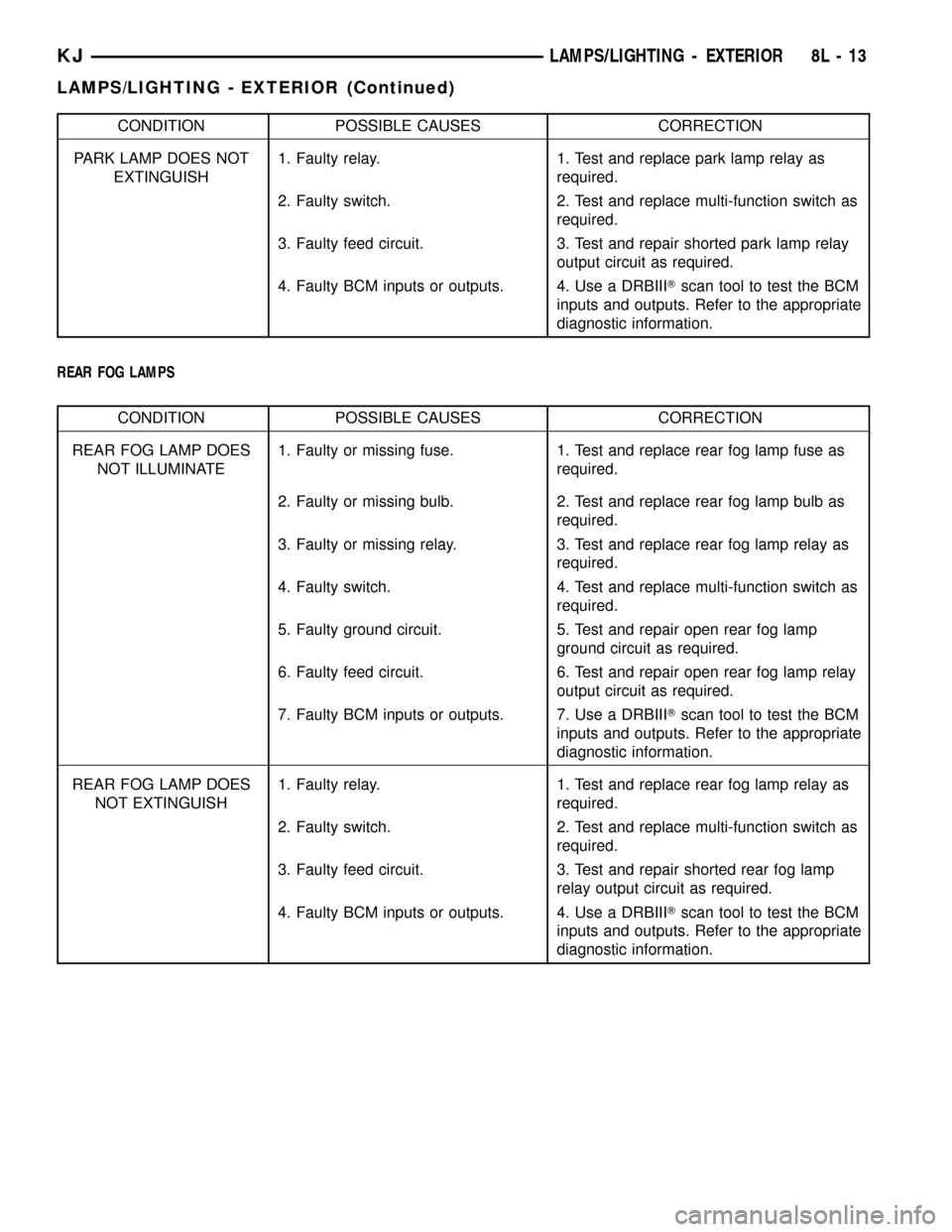relay JEEP LIBERTY 2002 KJ / 1.G Manual PDF
[x] Cancel search | Manufacturer: JEEP, Model Year: 2002, Model line: LIBERTY, Model: JEEP LIBERTY 2002 KJ / 1.GPages: 1803, PDF Size: 62.3 MB
Page 448 of 1803

leveling switch is a resistor multiplexed unit that
provides one of four voltage outputs to the headlamp
leveling motors. The headlamp leveling motors will
move the headlamps to the selected position based
upon the voltage input received from the switch. The
headlamp leveling motors and switch have a path to
ground at all times. The headlamp leveling compo-
nents operate on battery current received through
the fused park lamp relay output circuit so that the
system will only operate when the exterior lighting is
turned on.
PARK LAMPS
The park lamps system includes the Body Control
Module (BCM), a park lamp relay installed in the
Junction Block (JB), and the exterior lighting switch
integral to the left (lighting) control stalk of the
multi-function switch. The front park lamp and side
marker or, if equipped, the front position lamp bulbs
each have a path to ground at all times through their
connections to the grille opening reinforcement wire
harness from two take outs of the headlamp and
dash wire harness with eyelet terminal connectors
that are secured by ground screws to the left inner
fender shield in the engine compartment. The rear
park lamp bulbs and license plate lamp have a path
to ground at all times through their connection to the
rear lighting wire harness from a take out of the rear
body wire harness with an eyelet terminal connector
that is secured by a ground screw to the base of the
right D-pillar behind the quarter trim panel. The
BCM controls the park lamp operation by monitoring
the exterior lighting switch inputs from the multi-
function switch, then energizing or de-energizing the
control coil of the park lamp relay. When the park
lamp relay is energized, it provides battery current
from a fused B(+) fuse in the Power Distribution
Center (PDC) through a park lamp relay output cir-
cuit and a separate fuse in the JB through a fused
park lamp relay output circuit to the appropriate
lamp bulb filaments. The BCM provides a battery
saver (load shedding) feature for the park lamps,
which will turn these lamps off if they are left on for
more than about eight minutes with the ignition
switch in the Off position.
REAR FOG LAMPS
Rear fog lamps are installed on vehicles manufac-
tured for certain markets where they are required.
The rear fog lamp system includes a premium Body
Control Module (BCM), a rear fog lamp relay
installed in the Junction Block (JB), and a rear fog
lamp switch integral to the left (lighting) control
stalk of the multi-function switch. The rear fog lamps
have a path to ground at all times through their con-
nection to the rear lighting wire harness from a takeout of the rear body wire harness with an eyelet ter-
minal connector that is secured by a ground screw to
the base of the right D-pillar behind the quarter trim
panel. The BCM controls rear fog lamp operation by
monitoring the exterior lighting switch input from
the multi-function switch, then energizing or de-ener-
gizing the rear fog lamp relay control coil; and, by
sending the appropriate electronic message to the
instrument cluster over the Programmable Commu-
nications Interface (PCI) data bus to turn the rear
fog lamp indicator on or off. When the rear fog lamp
relay is energized, it provides battery current from a
fused B(+) fuse in the JB to the rear fog lamps
through the rear fog lamp relay output circuit. The
BCM provides a battery saver (load shedding) feature
for the rear fog lamps, which will turn these lamps
off if they are left on for more than about eight min-
utes with the ignition switch in the Off position.
TURN SIGNAL LAMPS
When the left control stalk of the multi-function
switch is moved up (right turn) or down (left turn),
the turn signal system is activated causing the
selected right or left turn signal indicator, and right
or left turn signal lamps to flash on and off. When
the turn signal system is activated, the circuitry
within the turn signal switch and the hazard switch/
electronic combination flasher unit will repeatedly
energize and de-energize one of two internal relays
that switch battery current from a fused ignition
switch output (run) fuse in the Junction Block (JB) to
the right side or left side turn signal indicators and
turn signal lamps through the right or left turn sig-
nal circuits. The ElectroMechanical Instrument Clus-
ter (EMIC) chime tone generator will generate an
audible turn signal cancel warning each time the
vehicle is driven for a distance of about 3.2 kilome-
ters (about two miles) with a turn signal indicator
flashing. The EMIC uses Programmable Communica-
tions Interface (PCI) data bus distance messages
from the Powertrain Control Module (PCM) and a
hard wired input from the turn signal switch cir-
cuitry of the multi-function switch to determine when
to sound the turn signal cancel warning.
DIAGNOSIS AND TESTING - LAMPS/LIGHTING
- EXTERIOR
The hard wired circuits and components of the
exterior lighting systems may be diagnosed and
tested using conventional diagnostic tools and proce-
dures. However, conventional diagnostic methods
may not prove conclusive in the diagnosis of the Body
Control Module (BCM), the ElectroMechanical
Instrument Cluster (EMIC), the Powertrain Control
Module (PCM), or the Programmable Communica-
tions Interface (PCI) data bus network. The most
KJLAMPS/LIGHTING - EXTERIOR 8L - 7
LAMPS/LIGHTING - EXTERIOR (Continued)
Page 450 of 1803

BRAKE LAMPS
CONDITION POSSIBLE CAUSES CORRECTION
BRAKE LAMP DOES NOT
ILLUMINATE1. Faulty or missing fuse. 1. Test and replace brake lamp fuse as
required.
2. Faulty or missing bulb. 2. Test and replace brake lamp bulb as
required.
3. Faulty switch. 3. Test and replace brake lamp switch as
required.
4. Faulty ground circuit. 4. Test and repair brake lamp ground circuit
as required.
5. Faulty feed circuit. 5. Test and repair open brake lamp switch
output circuit as required.
BRAKE LAMP DOES NOT
EXTINGUISH1. Faulty switch. 1. Test and replace brake lamp switch as
required.
2. Faulty feed circuit. 2. Test and repair shorted brake lamp
switch output circuit as required.
DAYTIME RUNNING LAMPS
Before performing the following tests, determine
whether the headlamp low and high beams operate.If the headlamp high and low beams are also inoper-
ative, diagnose and repair that problem before
attempting to repair the Daytime Running Lamps.
CONDITION POSSIBLE CAUSES CORRECTION
DAYTIME RUNNING
LAMPS WILL NOT
ILLUMINATE1. High beam relay installed. 1. Remove high beam relay as required.
2. Faulty or missing DRL relay. 2. Replace DRL relay with a known good
unit and check operation. Replace DRL
relay as required.
3. Incorrect BCM programming. 3. Use a DRBIIITscan tool to check and
program correct country code into BCM as
required.
4. Faulty BCM inputs or outputs. 4. Use a DRBIIITscan tool to test the BCM
inputs or outputs. Refer to the appropriate
diagnostic information.
KJLAMPS/LIGHTING - EXTERIOR 8L - 9
LAMPS/LIGHTING - EXTERIOR (Continued)
Page 451 of 1803

FRONT FOG LAMPS
CONDITION POSSIBLE CAUSES CORRECTION
FRONT FOG LAMP DOES
NOT ILLUMINATE1. Faulty or missing fuse. 1. Test and replace front fog lamp fuse as
required.
2. Faulty or missing bulb. 2. Test and replace front fog lamp bulb as
required.
3. Faulty or missing relay. 3. Test and replace front fog lamp relay as
required.
4. Faulty switch. 4. Test and replace multi-function switch as
required.
5. Faulty ground circuit. 5. Test and repair front fog lamp ground
circuit as required.
6. Faulty feed circuit. 6. Test and repair open front fog lamp relay
output circuit as required.
7. Faulty BCM inputs or outputs. 7. Use a DRBIIITscan tool to test the BCM
inputs and outputs. Refer to the appropriate
diagnostic information.
FRONT FOG LAMP DOES
NOT EXTINGUISH1. Faulty relay. 1. Test and replace front fog lamp relay as
required.
2. Faulty switch. 2. Test and replace multi-function switch as
required.
3. Faulty feed circuit. 3. Test and repair shorted front fog lamp
relay output circuit as required.
4. Faulty BCM inputs or outputs. 4. Use a DRBIIITscan tool to test the BCM
inputs and outputs. Refer to the appropriate
diagnostic information.
HAZARD WARNING LAMPS
Before performing the following tests, confirm
whether the left and right turn signals operate satis-
factorily. If the turn signals are inoperative or oper-ate improperly, diagnose and repair that problem
before attempting to repair the Hazard Warning
Lamps.
CONDITION POSSIBLE CAUSES CORRECTION
HAZARD WARNING
LAMPS DO NOT FLASH1. Faulty or missing fuse. 1. Test and replace hazard warning fuse as
required.
2. Faulty ground circuit. 2. Test and repair hazard switch ground
circuit as required.
3. Faulty feed circuit. 3. Test and repair open hazard switch fused
B(+) circuit as required.
4. Faulty switch/flasher. 4. Replace hazard switch/combination
flasher with a known good unit and check
operation. Replace hazard switch/
combination flasher unit if required.
8L - 10 LAMPS/LIGHTING - EXTERIORKJ
LAMPS/LIGHTING - EXTERIOR (Continued)
Page 452 of 1803

HEADLAMPS
CONDITION POSSIBLE CAUSES CORRECTION
HEADLAMP DOES NOT
ILLUMINATE1. Faulty or missing fuse. 1. Test and replace headlamp fuse as
required.
2. Faulty or missing bulb. 2. Test and replace headlamp bulb as
required.
3. Faulty or missing relay. 3. Test and replace low beam or high beam
relay as required. (Note: Vehicles with a DRL
relay do not use a high beam relay. The DRL
relay cannot be tested. Replace DRL relay
with a known good unit and check operation.
Replace DRL relay as required.)
4. Faulty switch. 4. Test and replace multi-function switch as
required.
5. Faulty ground circuit. 5. Test and repair open headlamp ground
circuit as required.
6. Faulty feed circuit. 6. Test and repair open headlamp low beam,
high beam, or DRL relay output circuit as
required.
7. Faulty BCM inputs or outputs. 7. Use a DRBIIITscan tool to test the BCM
inputs and outputs. Refer to the appropriate
diagnostic information.
HEADLAMP DOES NOT
EXTINGUISH1. Faulty relay. 1. Test and replace low beam or high beam
relay as required. (Note: Vehicles with a DRL
relay do not use a high beam relay. The DRL
relay cannot be tested. Replace DRL relay
with a known good unit and check operation.
Replace DRL relay as required.)
2. Faulty switch. 2. Test and replace multi-function switch as
required.
3. Faulty feed circuit. 3. Test and repair shorted headlamp low
beam, high beam, or DRL relay output circuit
as required.
4. Faulty BCM inputs or outputs. 4. Use a DRBIIITscan tool to test the BCM
inputs and outputs. Refer to the appropriate
diagnostic information.
HEADLAMPS WILL NOT
SWITCH FROM HIGH TO
LOW BEAMS, OR FROM
LOW TO HIGH BEAMS1. Faulty relay. 1. Test and replace low beam or high beam
relay as required. (Note: Vehicles with a DRL
relay do not use a high beam relay. The DRL
relay cannot be tested. Replace DRL relay
with a known good unit and check operation.
Replace DRL relay as required.)
2. Faulty switch. 2. Test and replace multi-function switch as
required.
3. Faulty BCM inputs or outputs. 3. Use a DRBIIITscan tool to test the BCM
inputs and outputs. Refer to the appropriate
diagnostic information.
KJLAMPS/LIGHTING - EXTERIOR 8L - 11
LAMPS/LIGHTING - EXTERIOR (Continued)
Page 453 of 1803

HEADLAMP LEVELING
Before performing the following tests, confirm
whether the park lamps operate satisfactorily. If thepark lamps are inoperative, diagnose and repair that
problem before attempting to repair the Headlamp
Leveling System.
CONDITION POSSIBLE CAUSES CORRECTION
ONE LEVELING MOTOR
IS INOPERATIVE1. Faulty ground circuit. 1. Test and repair open leveling motor
ground circuit as required.
2. Faulty feed circuit. 2. Test and repair open leveling motor feed
circuit as required.
3. Faulty signal circuit. 3. Test and repair open headlamp adjust
signal circuit as required.
4. Faulty motor. 4. Test and replace headlamp leveling
motor as required.
BOTH LEVELING
MOTORS ARE
INOPERATIVE1. Faulty switch ground circuit. 1. Test and repair open leveling switch
ground circuit as required.
2. Faulty motor ground circuit. 2. Test and repair open leveling motor
ground circuit as required.
3. Faulty switch feed circuit. 3. Test and repair open leveling switch feed
circuit as required.
4. Faulty motor feed circuit. 4. Test and repair open leveling motor feed
circuit as required.
5. Faulty signal circuit. 5. Test and repair open or shorted leveling
motor signal circuit as required.
6. Faulty switch. 6. Test and replace leveling switch as
required.
7. Faulty motors. 7. Test and replace leveling motors as
required.
PARK LAMPS
CONDITION POSSIBLE CAUSES CORRECTION
PARK LAMP DOES NOT
ILLUMINATE1. Faulty or missing fuse. 1. Test and replace park lamp fuse as
required.
2. Faulty or missing bulb. 2. Test and replace park lamp bulb as
required.
3. Faulty or missing relay. 3. Test and replace park lamp relay as
required.
4. Faulty switch. 4. Test and replace multi-function switch as
required.
5. Faulty ground circuit. 5. Test and repair open park lamp ground
circuit as required.
6. Faulty feed circuit. 6. Test and repair open park lamp relay
output circuit as required.
7. Faulty BCM inputs or outputs. 7. Use a DRBIIITscan tool to test the BCM
inputs and outputs. Refer to the appropriate
diagnostic information.
8L - 12 LAMPS/LIGHTING - EXTERIORKJ
LAMPS/LIGHTING - EXTERIOR (Continued)
Page 454 of 1803

CONDITION POSSIBLE CAUSES CORRECTION
PARK LAMP DOES NOT
EXTINGUISH1. Faulty relay. 1. Test and replace park lamp relay as
required.
2. Faulty switch. 2. Test and replace multi-function switch as
required.
3. Faulty feed circuit. 3. Test and repair shorted park lamp relay
output circuit as required.
4. Faulty BCM inputs or outputs. 4. Use a DRBIIITscan tool to test the BCM
inputs and outputs. Refer to the appropriate
diagnostic information.
REAR FOG LAMPS
CONDITION POSSIBLE CAUSES CORRECTION
REAR FOG LAMP DOES
NOT ILLUMINATE1. Faulty or missing fuse. 1. Test and replace rear fog lamp fuse as
required.
2. Faulty or missing bulb. 2. Test and replace rear fog lamp bulb as
required.
3. Faulty or missing relay. 3. Test and replace rear fog lamp relay as
required.
4. Faulty switch. 4. Test and replace multi-function switch as
required.
5. Faulty ground circuit. 5. Test and repair open rear fog lamp
ground circuit as required.
6. Faulty feed circuit. 6. Test and repair open rear fog lamp relay
output circuit as required.
7. Faulty BCM inputs or outputs. 7. Use a DRBIIITscan tool to test the BCM
inputs and outputs. Refer to the appropriate
diagnostic information.
REAR FOG LAMP DOES
NOT EXTINGUISH1. Faulty relay. 1. Test and replace rear fog lamp relay as
required.
2. Faulty switch. 2. Test and replace multi-function switch as
required.
3. Faulty feed circuit. 3. Test and repair shorted rear fog lamp
relay output circuit as required.
4. Faulty BCM inputs or outputs. 4. Use a DRBIIITscan tool to test the BCM
inputs and outputs. Refer to the appropriate
diagnostic information.
KJLAMPS/LIGHTING - EXTERIOR 8L - 13
LAMPS/LIGHTING - EXTERIOR (Continued)
Page 460 of 1803

INSTALLATION
CAUTION: Always use the correct bulb size and
type for replacement. An incorrect bulb size or type
may overheat and cause damage to the lamp, the
socket and/or the lamp wiring.
(1) Align the base of the bulb with the receptacle
in the Center High Mounted Stop Lamp (CHMSL)
unit socket.
(2) Push the bulb straight into the CHMSL unit
socket until it is firmly seated.
(3) Align the socket and bulb with the socket open-
ing on the back of CHMSL unit housing.
(4) Push the socket and bulb straight into the
CHMSL unit housing until it is firmly seated (Fig. 6).
(5) Rotate the socket on the back of the CHMSL
unit housing clockwise about 30 degrees.
(6) Reinstall the CHMSL unit onto the roof panel.
(Refer to 8 - ELECTRICAL/LAMPS/LIGHTING -
EXTERIOR/CENTER HIGH MOUNTED STOP
LAMP UNIT - INSTALLATION).
(7) Reconnect the battery negative cable.
CENTER HIGH MOUNTED
STOP LAMP UNIT
REMOVAL
(1) Disconnect and isolate the battery negative
cable.
(2) Remove the two screws that secure the Center
High Mounted Stop Lamp (CHMSL) unit to the rear
of the roof panel (Fig. 7).
(3) Pull the CHMSL unit away from the roof panel
far enough to access and disconnect the wire harness
connector for the CHMSL unit from the lamp socket
pigtail wire.
(4) Remove the CHMSL unit from the roof panel.
INSTALLATION
(1) Position the Center High Mounted Stop Lamp
(CHMSL) unit to the roof panel.
(2) Reconnect the wire harness connector for the
CHMSL unit to the lamp socket pigtail wire (Fig. 7).
(3) Position the CHMSL unit into the roof panel
opening.
(4) Install and tighten the two screws that secure
the CHMSL unit to the rear of the roof panel.
Tighten the screws to 2 N´m (21 in. lbs.).
(5) Reconnect the battery negative cable.
COMBINATION FLASHER
DESCRIPTION
The combination flasher for this model is integral
to the hazard switch located in the center of the
instrument panel, just above the radio. The combina-
tion flasher is a smart relay that functions as both
the turn signal system and the hazard warning sys-
tem flasher. The combination flasher contains active
electronic Integrated Circuitry (IC) elements. This
flasher is designed to handle the current flow
requirements of the factory-installed lighting. If sup-
plemental lighting is added to the turn signal lamp
circuits, such as when towing a trailer with lights,
the combination flasher will automatically try to
compensate to keep the flash rate the same.
The combination flasher cannot be repaired or
adjusted and, if faulty or damaged, the hazard switch
unit must be replaced.
OPERATION
The combination flasher has the following inputs and
outputs: fused B(+), fused ignition switch output, right
turn signal sense, left turn signal sense, and one output
each for the right and left turn signal circuits. The com-
bination flasher also receives an internal input through
the closed contacts of the hazard switch and, on vehicles
equipped with the optional Vehicle Theft Security Sys-
tem (VTSS), the flasher receives an input from the Body
Control Module (BCM) in order to flash the turn signal
lamps as an optical alert feature of that system. Con-
Fig. 7 Center High Mounted Stop Lamp Remove/
Install
1 - ROOF PANEL
2 - BODY WIRE HARNESS CONNECTOR
3 - BULB SOCKET
4 - CHMSL
5 - SCREW (2)
6 - PLASTIC NUT (2)
KJLAMPS/LIGHTING - EXTERIOR 8L - 19
CENTER HIGH MOUNTED STOP LAMP BULB (Continued)
Page 461 of 1803

stant battery voltage is supplied to the flasher so that it
can perform the hazard warning function, and ignition
switched battery voltage is supplied for the turn signal
function. The Integrated Circuit (IC) within the combi-
nation flasher contains the logic that controls the
flasher operation and the flash rate. The IC receives
separate sense ground inputs from the multi-function
switch for the right and left turn signals, and from the
hazard switch contacts or the BCM for the hazard
warning signals. A special design feature of the combi-
nation flasher allows it to9sense9that a turn signal cir-
cuit or bulb is not operating, and provide the driver an
indication of the condition by flashing the remaining
bulbs in the affected circuit at a higher rate (120 flash-
es-per-minute or higher). Conventional flashers either
continue flashing at their typical rate (heavy-duty type),
or discontinue flashing the affected circuit entirely
(standard-duty type).
Because of the active electronic elements within
the combination flasher, it cannot be tested with con-
ventional automotive electrical test equipment. If the
combination flasher is believed to be faulty, test the
turn signal and hazard warning system. Then
replace the hazard switch with a known good unit to
confirm system operation.
DAYTIME RUNNING LAMP
RELAY
DESCRIPTION
The Daytime Running Lamp (DRL) relay (Fig. 8) is
a solid state relay that is used only on vehicles man-
ufactured for sale in Canada. The DRL relay features
a die cast aluminum housing with integral cooling
fins that act as a heat sink for the solid state DRL
circuitry. Four male spade terminals extend from the
base of the relay through a potting material that
encloses and protects the DRL circuitry. Although the
DRL relay has four terminals that are laid out in a
footprint that is similar to that of a conventional
International Standards Organization (ISO) relay, a
standard ISO relay should never be installed in place
of the DRL relay. The DRL relay is installed in the
Junction Block (JB) on the driver side outboard end
of the instrument panel. Vehicles equipped with this
relay do not have a headlamp high beam relay
installed in the JB.
The DRL relay cannot be adjusted or repaired and,
if faulty or damaged, the unit must be replaced.
OPERATION
The Daytime Running Lamp (DRL) relay is a solid
state relay that controls the flow of battery current
to the high beam filaments of both headlamp bulbs
based upon a duty cycled control input received from
the Body Control Module (BCM) of vehicles equipped
with the DRL feature. By cycling the DRL relay out-
put, the BCM controls the illumination intensity of
the high beam filaments. The DRL relay terminals
are connected to the vehicle electrical system through
a connector receptacle in the Junction Block (JB).
The inputs and outputs of the DRL relay include:
²Battery Current Input- The DRL relay
receives battery current on a fused B(+) circuit from
a fuse in the Power Distribution Center (PDC).
²Ground Input- The DRL relay receives a path
to ground through a splice block located in the
instrument panel wire harness with an eyelet termi-
nal connector that is secured by a nut to a ground
stud on the driver side instrument panel end bracket
near the Junction Block (JB).
²Control Input- The DRL relay control input is
received from the BCM and/or the momentary optical
horn (flash-to-pass) output of the multi-function
switch through a high beam relay control circuit.
²Control Output- The DRL relay supplies bat-
tery current output to the headlamp high beam fila-
ments through the high beam relay output circuit.
Because of active electronic elements within the
DRL relay, it cannot be tested with conventional
automotive electrical test equipment. If the DRL
relay is believed to be faulty, replace the relay with a
known good unit to confirm system operation.
Fig. 8 Daytime Running Lamp Relay
1 - DRL RELAY
2 - HEAT SINK
3 - POTTING MATERIAL
4 - TERMINAL (4)
8L - 20 LAMPS/LIGHTING - EXTERIORKJ
COMBINATION FLASHER (Continued)
Page 462 of 1803

REMOVAL
WARNING: ON VEHICLES EQUIPPED WITH AIR-
BAGS, DISABLE THE SUPPLEMENTAL RESTRAINT
SYSTEM BEFORE ATTEMPTING ANY STEERING
WHEEL, STEERING COLUMN, DRIVER AIRBAG,
PASSENGER AIRBAG, SEAT BELT TENSIONER,
FRONT IMPACT SENSORS, SIDE CURTAIN AIRBAG,
OR INSTRUMENT PANEL COMPONENT DIAGNOSIS
OR SERVICE. DISCONNECT AND ISOLATE THE
BATTERY NEGATIVE (GROUND) CABLE, THEN
WAIT TWO MINUTES FOR THE SYSTEM CAPACI-
TOR TO DISCHARGE BEFORE PERFORMING FUR-
THER DIAGNOSIS OR SERVICE. THIS IS THE ONLY
SURE WAY TO DISABLE THE SUPPLEMENTAL
RESTRAINT SYSTEM. FAILURE TO TAKE THE
PROPER PRECAUTIONS COULD RESULT IN ACCI-
DENTAL AIRBAG DEPLOYMENT AND POSSIBLE
PERSONAL INJURY.
(1) Disconnect and isolate the battery negative
cable.
(2) Remove the end cap from the driver side out-
board end of the instrument panel. (Refer to 23 -
BODY/INSTRUMENT PANEL/INSTRUMENT
PANEL END CAP - REMOVAL).
(3) Remove the Daytime Running Lamp (DRL)
relay by grasping it firmly and pulling it straight out
from the receptacle in the Junction Block (JB) (Fig.
9).
INSTALLATION
WARNING: ON VEHICLES EQUIPPED WITH AIR-
BAGS, DISABLE THE SUPPLEMENTAL RESTRAINT
SYSTEM BEFORE ATTEMPTING ANY STEERING
WHEEL, STEERING COLUMN, DRIVER AIRBAG,
PASSENGER AIRBAG, SEAT BELT TENSIONER,
FRONT IMPACT SENSORS, SIDE CURTAIN AIRBAG,
OR INSTRUMENT PANEL COMPONENT DIAGNOSIS
OR SERVICE. DISCONNECT AND ISOLATE THE
BATTERY NEGATIVE (GROUND) CABLE, THEN
WAIT TWO MINUTES FOR THE SYSTEM CAPACI-
TOR TO DISCHARGE BEFORE PERFORMING FUR-
THER DIAGNOSIS OR SERVICE. THIS IS THE ONLY
SURE WAY TO DISABLE THE SUPPLEMENTAL
RESTRAINT SYSTEM. FAILURE TO TAKE THE
PROPER PRECAUTIONS COULD RESULT IN ACCI-
DENTAL AIRBAG DEPLOYMENT AND POSSIBLE
PERSONAL INJURY.
(1) Position the Daytime Running Lamp (DRL)
relay to the proper receptacle in the Junction Block
(JB) (Fig. 9).
(2) Align the DRL relay terminals with the termi-
nal cavities in the JB receptacle.
(3) Push firmly and evenly on the top of the DRL
relay until the terminals are fully seated in the ter-
minal cavities in the JB receptacle.
(4) Reinstall the end cap onto the driver side out-
board end of the instrument panel. (Refer to 23 -
BODY/INSTRUMENT PANEL/INSTRUMENT
PANEL END CAP - INSTALLATION).
(5) Reconnect the battery negative cable.
FRONT FOG LAMP BULB
REMOVAL
(1) Turn the front wheels full lock in the direction
of the fog lamp bulb that is to be changed.
(2) Disconnect and isolate the battery negative
cable.
(3) Reach into the front wheel opening to unsnap
and lift the cover over the access hole at the front of
the front wheelhouse splash shield (Fig. 10).
(4) Reach through the access hole and firmly grasp
the socket on the back of the front fog lamp unit
housing.
(5) Rotate the socket on the back of the front fog
lamp unit housing counterclockwise about 30
degrees.
CAUTION: Do not contaminate the bulb glass by
touching it with your fingers or by allowing it to
contact other oily surfaces. Shortened bulb life will
result.
Fig. 9 Junction Block - Outboard Side (RHD Shown
- Rotate 180É for LHD)
1 - JB/BCM CONNECTOR
2 - HIGH BEAM RELAY
3 - DRL RELAY
KJLAMPS/LIGHTING - EXTERIOR 8L - 21
DAYTIME RUNNING LAMP RELAY (Continued)
Page 463 of 1803

(6) Pull the socket and bulb straight out of the
front fog lamp unit housing and through the access
hole into the front wheel opening area.
(7) Pull the bulb straight out of the front fog lamp
unit socket.
INSTALLATION
CAUTION: Always use the correct bulb size and
type for replacement. An incorrect bulb size or type
may overheat and cause damage to the lamp, the
socket and/or the lamp wiring.
CAUTION: Do not contaminate the bulb glass by
touching it with your fingers or by allowing it to
contact other oily surfaces. Shortened bulb life will
result.
(1) Align the base of the bulb with the receptacle
in the front fog lamp unit socket.
(2) Push the bulb straight into the front fog lamp
unit socket until it is firmly seated.
(3) Position the socket and bulb through the access
hole in the front wheelhouse splash shield and align
it with the socket opening on the back of the front
fog lamp unit housing (Fig. 10).
(4) Push the socket and bulb straight into the
front fog lamp unit housing until it is firmly seated.
(5) Rotate the socket on the back of the front fog
lamp unit housing clockwise about 30 degrees.
(6) Lower and snap shut the access cover over the
hole at the front of the front wheelhouse splash
shield.
(7) Reconnect the battery negative cable.
FRONT FOG LAMP RELAY
DESCRIPTION
The front fog lamp relay is located in the Junction
Block (JB) on the driver side outboard end of the
instrument panel in the passenger compartment of
the vehicle. The front fog lamp relay is a conven-
tional International Standards Organization (ISO)
micro relay (Fig. 11). Relays conforming to the ISO
specifications have common physical dimensions, cur-
rent capacities, terminal patterns, and terminal func-
tions. The relay is contained within a small,
rectangular, molded plastic housing and is connected
to all of the required inputs and outputs by five inte-
gral male spade-type terminals that extend from the
bottom of the relay base.
The front fog lamp relay cannot be adjusted or
repaired and, if faulty or damaged, the unit must be
replaced.
OPERATION
The front fog lamp relay is an electromechanical
switch that uses a low current input from the Body
Control Module (BCM) to control a high current out-
put to the front fog lamps. The movable common feed
contact point is held against the fixed normally
closed contact point by spring pressure. When the
relay coil is energized, an electromagnetic field is
produced by the coil windings. This electromagnetic
field draws the movable relay contact point away
from the fixed normally closed contact point, and
holds it against the fixed normally open contact
Fig. 10 Front Fog Lamp Bulb Remove/Install
1 - FRONT WHEELHOUSE SPLASH SHIELD
2 - ACCESS HOLE
3 - SOCKET
4 - BULB
Fig. 11 ISO Micro Relay
30 - COMMON FEED
85 - COIL GROUND
86 - COIL BATTERY
87 - NORMALLY OPEN
87A - NORMALLY CLOSED
8L - 22 LAMPS/LIGHTING - EXTERIORKJ
FRONT FOG LAMP BULB (Continued)